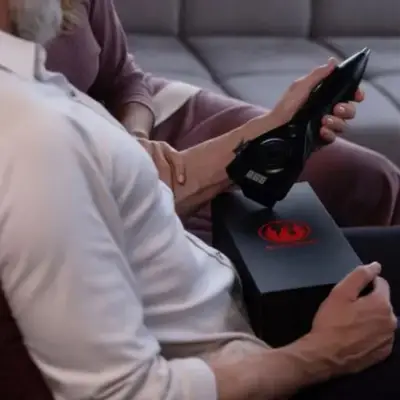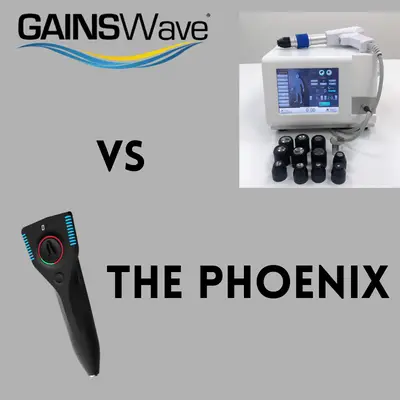TENS and ultrasound have been popular technological treatments for a long time. However, when you’re in pain, which is the smarter option?
So, between the TENS unit vs. ultrasound, which is better? While the science is still out on both treatments, and more studies are needed, most evidence states that ultrasound doesn’t help with pain relief. TENS has more scientific support, and several studies have found that it does help patients in pain. So, in that sense, TENS is definitely a better pain treatment.
Being informed about the state of your health and possible treatments is the first step to getting better. If you want to know more about TENS and ultrasound, as well as some of the studies about them, read on to learn more.
Benefits of TENS and Ultrasound
Both TENS and ultrasound are used to treat pain with different conditions. Let’s take a look at their benefits and usage.
TENS
TENS units are devices which provide pain relief for several conditions like:
- Neck, back, and shoulder pain
- Period and labor pain
- Joint pain
- Pain after surgeries
- Endometriosis
- Arthritis
- Spinal cord injuries
TENS also has proposed benefits for some other conditions, but these are the most common ones and the ones that are supported by research.
How High Should I Set My TENS Unit? click here to read what settings to use.
One of the main benefits of a TENS unit is that you can change the frequency, intensity, and duration of the treatment. There’s a dial that will allow you to switch between different intensities and a frequency adjuster, which changes the number of impulses per second. It’s generally better to use higher frequencies, such as between 80 and 120 impulses.
When it comes to duration, it’s best to use a TENS unit for about 15-20 minutes before changing the placement of electrodes.
The primary benefit of TENS units is generally in relieving pain. It works by blocking out the pain signals and by activating natural pain killers in the body. With TENS, you may be able to reduce the number of painkillers you use, reduce any addiction to them, get additional relief from pain, etc. It’s also portable and easy to use, so you can take your pain relief with you.
Want to know where a TENS unit can be placed? Check out my TENS placement guide here
Ultrasound
Ultrasound is commonly prescribed to people in pain, as it helps with the following conditions:
- Muscle knots
- Tendonitis
- Joint tightness
- Bursitis
- Frozen shoulder
In general, any injury to the soft tissue could be helped with ultrasound. It can even be used for back, neck and shoulder pain, ankle sprains, etc.
Ultrasound is a device that has a standard sound head, and it’s used with a conductor gel, which helps the sound transmit better. A therapist will move the head of the ultrasound machine in the area affected by pain. The movements will be slow and gentle, and you most likely won’t feel anything but that are getting a bit warmer. Tingling could be possible, but it’s not as common.
Ultrasound devices also come with different settings, and they often have to be just right in order to work. It can be used in combination with other forms of therapy like ice or hot packs, massage, etc., especially if there’s an open wound.
Unlike the stationary TENS electrodes, the ultrasound head needs to be constantly moved, or you’ll be in even more pain than when you started. Circular motion is best. If you feel any pain outside of what you’re already experiencing, you should let your doctor know immediately.
Ultrasound machines can also provide a deep heating effect. With this heating effect, muscles and tissues will have better blood flow, and circulation will help increase the range of motion while speeding up the healing process.
The Science Behind TENS
TENS therapy has been a popular treatment for many years now. At first, it was only available with medical professionals, but now everyone can get one — it’s as small as an MP3 player. It’s easy to use and carry around.
However, to understand how it works, you have to understand how pain works. It starts with pain receptors recording the pain and sending a signal to the brain through the spine and nerve fibers that you are in pain. TENS is there to block these signals by transmitting electrical currents through the skin and to those nerves. The electrical currents coming from TENS devices are low and should feel pleasant while being used.
However, as mentioned above, the science is still somewhat out on TENS, which means that scientists still haven’t concluded how it really helps. One theory, called the Gate Control Theory of Pain, was constructed by two scientists in 1965. It states that the central nervous system has a gate mechanism which lets through nerves. Larger nerves transmit touch signals, and smaller ones transmit pain.
The scientists behind Gate Control Theory of pain believed that larger nerves — the ones transmitting touch — have the ability to block the entrance to the nervous system, not allowing pain signals to go through.
Another theory is that endorphins — the body’s natural painkillers — activate because of the TENS stimulation, and that’s why patients using TENS start to feel relief. Research has confirmed that TENS does, in fact, stimulate endorphin production.
Some even believe that TENS is actually a placebo that’s supported by a sensation. The sensation makes the treatment seem legit, and people start to believe that they are not in pain, so that’s why the pain stops.
TENS therapy has been studied heavily for many different conditions, and one of the most successful and positive examples was a 1997 study that found that TENS was a great treatment for muscle knots.
Muscle knots are a type of musculoskeletal pain, and science has been struggling with it for years without a complete solution. It’s essentially a hard, painful knot of muscle that causes muscle pain or soreness.
This study compared plenty of different techniques — muscle stimulation, placebo, etc. — on 60 patients, and they found that TENS proved to be the best solution, enabling immediate relief and better range of motion. The study was small, but it helped show that TENS can be a reliable treatment for this condition.
Furthermore, one study found that TENS can provide immediate pain relief with higher frequencies but that lower frequencies are likely just good to activate endorphins. Another study found that repeated use can make pain relief effect longer — up to 24 hours.
In essence, science, although lacking in some aspects, has shown that TENS can be used effectively for different conditions.
The Science Behind Ultrasound
Ultrasound therapy involves the usage of sound waves that treat injuries. The sound is far higher than a human can hear, and it’s been in use since the 1950s. Therapists have been using different sound frequencies, intensities, and so on, but the basic principle is one of stimulating the sore tissue.
Ultrasound is used so much that many people just assume that it’s a proven thing. However, when you dig a little deeper, ultrasound turns out to be poorly supported by science for a number of uses. For one, it works on the principle of many other stimulation devices — the body just needs a bit of stimulation, and then nature can take over.
Ultrasound does have some promising research for certain conditions, but most studies have shown it to be ineffective. There is a lack of research to support any usage of this form of therapy. As far as science goes, it’s not even based on good theory.
Some patients find it effective sometimes, but this anecdotal evidence is not enough to support the volume of use it gets.
Let’s get into the specifics.
There are two forms of ultrasound therapy. For one, there’s the ordinary ultrasound therapy, which is familiar to most people who have ever had physical therapy. And there’s also the more expensive and painful ESWT of extracorporeal shock wave therapy.
The former devices are small, and you can buy them for home use. The treatment is easy to do, and it doesn’t cause any pain. The latter, ESWT, is a stronger and more intense therapy that will cause pain. The purpose behind both is the same — stimulate tissues so they can heal on their own. But ESWT may even be dangerous because its original purpose was to destroy gallstones, so it could harm the tissue.
To top it off, ESWT is also really expensive.
The trials for ultrasound therapy are few and far between. As one of the staples of therapy for pain, ultrasound should have more research supporting it. But unfortunately, there’s not. Most studies find that there’s not enough information about it, not enough testing or trials.
At the same time, this form of therapy is worth billions of dollars on the market, so there’s a jarring disconnect.
Considering that ultrasound is easy to test and that the results should be clear quickly, one evidence review found that there’s not enough proof based on 13 studies to support the use of musculoskeletal issues.
The same study does offer some hope when they mention that ultrasound could be good for tennis elbow and that it needs further research. But, other studies have been negative about the use of ultrasound for tennis elbow.
Why Ultrasound is So Common
So, why is ultrasound so common in physical therapy?
Well, the reason for that lies in the fact that ultrasound does work for some specific conditions, with very specific settings. Back when it was first used, this warranted enough respect from medical professionals, and the ultrasound stuck.
Of course, there are doctors who believe it doesn’t work, and they don’t recommend it, but the majority still supports it. The widespread use of this therapy is even bigger now that there’s a bigger price tag attached to it and a stronger intensity found in ESWT.
Some companies selling ESWT claim that it’s 80-85% effective, while there are no studies to support it. Recent research does reflect on the effectiveness of this form of therapy — not just for pain, but for stroke, ulcers, and erectile dysfunction — and some evidence is available, but not entirely.
- One study, performed in 2016, shows that ESWT is effective for relieving pain that comes from plantar fasciitis (plantar fasciitis is an irritation of the foot arch). As such, ESWT is one of the most common treatments for this condition.
- Another study found that this form of therapy is good for hip pain, and another found that it could be good for proximal hamstring tendinopathy. However, both need replication and reviews to legitimize them.
- A fourth study has also found that it could be good for a frozen shoulder condition, but only with a few small studies, not complete evidence.
- A general review by the British Medical Journal of Sports Medicine has recently gone through research on the use of ESWT for lower limb conditions. They found that only a few studies were promising, while rejecting 13 studies based on the fact that they were biased.
Even patients are getting skeptical. Especially so about general ultrasound therapy, as it often fails to provide results for them. There are bad reviews of ultrasound as a form of therapy everywhere.
At the same time, patients are generally not annoyed by ESWT as much since it’s newer, and it seems promising. Because it causes pain and it costs as much, patients often get the placebo effect — they want and need it to work, so it does. Even if they don’t get any benefits, they’ll still support it, claiming that it probably works for some people.
The main idea behind ultrasound is that tissues will respond to the vibrations it causes. Vibrating the cells will make them healthier or possibly stir them to start healing on their own. However, Physical Therapy published a review of the effects that the ultrasound provides, and the entire point of that review was that there is simply not enough evidence for any of those effects.
They also state that the beneficial effects don’t happen in real life, and evidence is, again, lacking.
Ultrasound is interesting as a form of therapy and as a healing method, but science has yet to discover and confirm which effects it actually provides. For example, an animal study states that the evidence is strong when it comes to ultrasound healing tendons, but animal studies are often very misleading — animals and people are not the same.
British Medical Journal presented a review in 2017 where they stated that ultrasound therapy doesn’t work for broken bones, but they had to conclude that the lack of research makes it possible that ultrasound could be good for something.
The entire science behind ultrasound is based on the claim that stimulation is good. However, no one has found what it could be good for or why.
Naturally, some scientists supporting ESWT or ultrasound cling to the gate control theory, but that theory is still shaky, even if important. The effect, if present, is only temporary. The “gate” is only blocked while stimulation is present.
There’s an interesting study performed by Canadian scientists on muscle knots and the effect of ultrasound on them. They compared the effects of ultrasound and sham therapy. After that, they tested the sensitivity of the affected areas — how much pressure they could take.
The affected tissues were less sensitive and could take more pressure after one minute, three minutes, and five minutes. But, this treatment was not effective after 10 or 15 minutes. This evidence suggests that ultrasound could be effective in the future if they figure out how to put it to use.
In essence, all of this suggests that ultrasound may have some benefits, but that the medical world is still not sure what those benefits are or which conditions it could treat.
Should You Use TENS or Ultrasound?
As you can see, TENS and ultrasound both work on the principle of stimulation — so the basis of each of them is the same. However, there are some significant differences in the amount of research that supports them and the method they use.
While ultrasound is there to simply “shake” the tissues into health, TENS sends electrical stimulation through the skin and blocks the feelings of pain. Ultrasound uses sound beyond our hearing specter, and TENS uses electrical stimulation.
In both cases, the theory suggests that this should work.
But, while many studies support the usage of TENS, especially for certain conditions, ultrasound has a huge gap there. The studies supporting it — or making any clear claims about it — are lacking and almost non-existent.
The one reason why you may see plenty of ultrasound and ESWT mentions is that ultrasound has been used for so long, and ESWT seems like a modern solution (especially because it’s expensive). So, this industry is thriving.
However, there’s not nearly enough evidence to back it up. TENS does still need research — like many physical therapy tools — but at least there are some definite answers about what it does and where it works.
If you need some pain relief and you are not sure whether to use TENS or ultrasound, it’s best to steer towards something that’s been backed by valid research.
Conclusion
As you can see from the suggested research, science favors TENS. However, even TENS works best with complementary therapy like ice packs and moist heat packs (not at the same time), and especially massage. So, consult your therapist on combining them.
As with most health issues, strive towards using acclaimed solutions and do your research before accepting any therapy. You can also talk to your doctors and see what they think would be best.
Sources
- NCBI: Response of plasma beta-endorphins to transcutaneous electrical nerve stimulation in healthy subjects.
- NCBI: Effect of low- and high-frequency TENS on Met-enkephalin-Arg-Phe and dynorphin A immunoreactivity in human lumbar CSF.
- NCBI: Using TENS for pain control: the state of the evidence
- NCBI: Transcutaneous Electrical Nerve Stimulation (TENS)
- NCBI: Effectiveness of Transcutaneous Electrical Nerve Stimulation for Treatment of Hyperalgesia and Pain
- University of Iowa: Transcutaneous electrical nerve stimulator (TENS
- NCBI: The immediate effectiveness of electrical nerve stimulation and electrical muscle stimulation on myofascial trigger points.
- NCBI: Constructing and Deconstructing the Gate Theory of Pain
- Nursing Times: Exploring the evidence for using TENS to relieve pain
- NCBI: Therapeutic ultrasound for chronic low-back pain.
- NCBI: Therapeutic ultrasound for carpal tunnel syndrome.
- NCBI: Therapeutic ultrasound for acute ankle sprains.
- NCBI: The effectiveness of therapeutic ultrasound for musculoskeletal conditions of the lower limb: A literature review.
- NCBI: Therapeutic ultrasound for osteoarthritis of the knee or hip.
- NCBI: Extracorporeal shock wave treatment for chronic lateral epicondylitis (tennis elbow).
- NCBI: Systematic review of the efficacy and safety of shock wave therapy for lateral elbow pain.
- NCBI: Ultrasound therapy for musculoskeletal disorders: a systematic review.
- NCBI: A randomized controlled trial of extracorporeal shock wave therapy for lateral epicondylitis (tennis elbow).
- NCBI: Stimulation of myofascial trigger points with ultrasound induces segmental antinociceptive effects: a randomized controlled study.
- NCBI: Low-intensity pulsed ultrasound for bone healing: a systematic review of randomized controlled trials.
- NCBI: Effect of therapeutic ultrasound on tendons.
- NCBI: The effectiveness of extracorporeal shockwave therapy in common lower limb conditions: a systematic review including quantification of patient-rated pain reduction.
- NCBI: Effectiveness of Extracorporeal Shock Wave Therapy Without Local Anesthesia in Patients With Recalcitrant Plantar Fasciitis: A Meta-Analysis of Randomized Controlled Trials.
- Oxford Academic: A Review of Therapeutic Ultrasound: Effectiveness Studies
- Oxford Academic: A Survey of Therapeutic Ultrasound Use by Physical Therapists Who Are Orthopaedic Certified Specialists
- Oxford Academic: A Review of Therapeutic Ultrasound: Biophysical Effects




